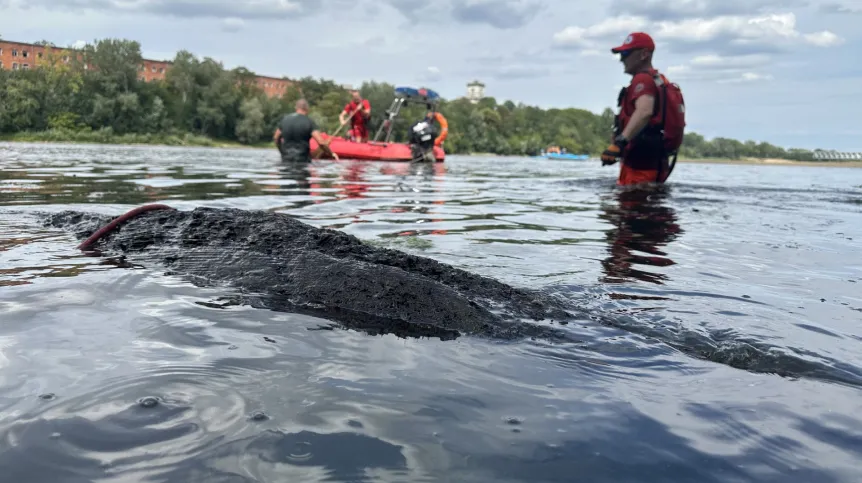
The oldest form of boat was found by searchers near the Modlin Fortress Granary, archaeologist Robert Wyrostkiewicz told PAP. The relic was in the water where the Narew flows into the Vistula.
The discovery of the dugout was made by a group of searchers led by Sławomir Kaliński, president of the Triglav association, searching with permission of the Mazovian Voivodeship Conservator of Monuments. The group turned to Robert Wyrostkiewicz from PogotowieArcheologiczne.pl with a request for archaeological consultation.
'Sławomir Kaliński alerted me on Saturday that something that looked like a dugout had been found. Initially, only a piece of the stern was visible and it was difficult to assess whether it was really an artefact or just a simple log of wood. The inspection was carried out with the participation of the Water Volunteer Emergency Service officers from Nowy Dwór Mazowiecki. I determined that it was an artefact and measured it. I determined that the boat was at a depth of about 80 cm on average, and its dimensions were 7 m 80 cm long and about 80 cm wide', the archaeologist said.
It turned out that the boat was quite large. 'Usually, dugouts were built for two rowers, they were 2-3 m, maximum 4 m long’, Wyrostkiewicz added, saying that the logboat was 'finely made'.
'The shipbuilder was quite skilled. At the end of the side, you can see a man-made rectangular hollow, perhaps for a steering element’.
The boat, which was made of hardwood, did not survive in its entirety and a large fragment was discovered without its bow.
Dugout canoes are the oldest forms of boats - the first of them were made from a single tree trunk in the Neolithic period. 'They were also used during the Roman period, and several hundred years later the Slavic fleet consisted of dugout canoes. We know that the Slavic warships were dugout canoes of larger sizes. Perhaps the object found now comes from an older period, but it might also be a 19th-century work. Due to the degree of damage, I would estimate its age at 200-300 years, so it may date back to royal times', said the archaeologist.
He added that precise dating would be possible after conducting dendrochronological research.
He added that in Polesie, dugout canoes were still being built in the 1930s.
Wyrostkiewicz said that the boat had now been secured. ’The dugout was hidden by WOPR a few hundred meters from the place of discovery - it was submerged and covered with stones. The water will provide relatively oxygen-free conditions that will preserve the monument until further research. The stones will prevent it from floating away, which has happened before with such finds’, he said.
The Mazovian Voivodeship Conservator of Monuments, Marcin Dawidowicz also drew attention to the need to secure the monument. 'In the case of objects made of wood, water (river) has a positive effect on their state of preservation. That is why the dugout was secured under the water surface. If the dugout was fished out and left in the open air, the wood would dry out and, as a result, it would decompose faster, it would fall apart', he told PAP.
The boat is now waiting for the appropriate museum unit to be selected to take over its care. (PAP)
PAP - Science in Poland
bar/ mhr/ kap/
tr. RL













